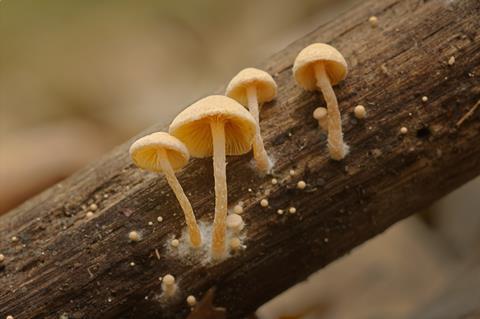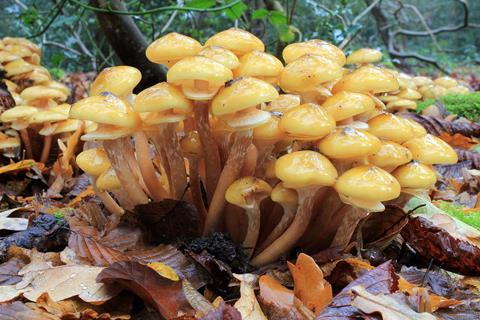In 2012, The United Nations announced 21 March to be the International Day of Forests.
Forests are incredibly biodiverse, being one of the richest biological areas on the planet. When thinking of forests, you may first think of trees and shrubs, overlooking the variety of lifeforms coexisting in this habitat, including animals (mammals, birds, and invertebrates) and microorganisms (fungi, bacteria, and archaea). This article will delve into the weird and wonderful existence of fungi in forests, a key contributor to forest biodiversity and one of the more unusual microorganisms thriving in the forest habitat.
Promoted: AMI has teamed up with QIAGEN to help you get the highest yields from your soil DNA Extractions. Get your free guide here.
There are around 144,000 known species of fungi, of which over 100,000 reside in forest landscapes. The fungi kingdom is broad, encompassing a variety of organisms like mushrooms, moulds and mildew, with many species essential for regulating the forest ecosystem. Fungi can broadly be split into three relationship categories symbiotic, parasitic, and saprophytic, each having a unique function to shape forests as we know them today.
Symbiotic relationships within forest habitats
90% of plant species form symbiotic relationships with fungal species, and these mutualistic relationships play a crucial part in the forest ecosystem. Mycorrhizal fungi grow in association with plant roots, with the hyphal network acting as an extension of the roots to increase the absorption area for water and other nutrients like nitrogen and phosphorus. In exchange, the fungi can feed on the carbohydrates produced by the plants. This relationship is highly beneficial and can prevent fungal disease by other attacking fungi species.
The two main classifications of mycorrhizal types are ectomycorrhizas (found colonising intercellular space and on the roots cell surface) and endomycorrhizas (found colonising the internal cell space). These studies have highlighted that ectomycorrhizas dominate forests, with many common tree families like Pinaceae Eucalyptus and Fagaceae interacting.
Saprophytes
Most fungal species are saprophytic, living off dead organic material. They secrete extracellular enzymes to break down decaying or dead matter, cycling nutrients back into the soil. Saprophytic organisms are crucial for ecological balance, providing a route for complex matter to be recycled back into required nutrients for the ecosystem. For example, lignin is a complex compound resistant primarily to microbial decomposition; fungi are one of the few microbes that successfully break down lignin into usable compounds.

Parasitic fungi
Whilst most fungi form mutualistic relationships, pathogenic and parasitic fungi form a symbiotic relationship at the detriment of tree/shrub health. Entering the plant through natural openings such as leaf stoma, the fungi invade, living off the nutrients within the cell cytoplasm. Parasitic and pathogenic fungi are key in shaping the ecological biosphere, having the ability to wipe out species of trees and shrubs, reshaping the forest landscape.
A common example of a parasitic fungus is Honey Fungus (Armillaria mellea), found primarily attacking coniferous and broad-leaf trees in the new forest. The fungus causes white rot; however, no effective control methods currently exist. The fungus is also called boot-lace fungus due to the long black cords called rhizomorphs, which allow the effective spread of the fungi from one tree to another.

Food, glorious food
Whilst fungi influence forest habitat, once harvested, they can have a huge impact outside the ecosystem as food, medicine and poison sources. Listed below are some funky fungi which prove to be more than just forest floor fodder.
Mushrooms are edible fruiting bodies of several species of macrofungi. They are nutrient-dense, high in fibre, rich in vitamins, and their use as food has been recorded as far back as the ancient Greeks and Romans. Today many species of fungi are chef delicacies and play centre stage on plates, creating culinary masterpieces. For example, Pleurotus ostreatus, known as oyster mushrooms, grow in a temperate, subtropical forest, popular in Chinese, Japanese, and Korean cuisine. Lion’s Mane Mushroom (Hericium erinaceus) is another fungus used in food, containing compounds which benefit cognitive health. Some people say it tastes like seafood or crab meat, making it a superb substitute for vegan and vegetarian dishes.

Marvellous medicinal mushrooms
Whilst nutritious, fungi possess healing properties and are key ingredients in ancient medicine. Essential health benefits include being anti-inflammatory, a source of vitamin D and have anticancer properties. Ancient Chinese and Asian medicines rely heavily on fungi as a powerful tool to fight illness. Today we see an increase in studies into the medicinal properties of mushrooms, for example, Shiitake mushroom extracts and reishi mushrooms as part of cancer treatments. Another novel fungus used is Tolypocladium inflatum in cosmetic surgery and organ transplantation. The fungus produces Cyclosporine, which suppresses the immune system to help improve organ acceptance after transplants.

Toxic toadstools
Flamboyant fungi may be eye-catching, but there are some extremely dangerous species. This is one microorganism not to mess with! There have been multiple citations of ancient civilisations using fungi as a poison against their enemies in biological warfare, but more commonly, poisoning incidents happen through accidental ingestion. A notable example is the Death Cap (Amanita phalloides) fungi, associated with 90% of all mushroom-related poisonings worldwide. There have been fictional stories of death cap poisoning, but it is believed that this deadly fungus was used to kill the Holy Roman Emperor Charles VI in Vienna in 1740.








No comments yet